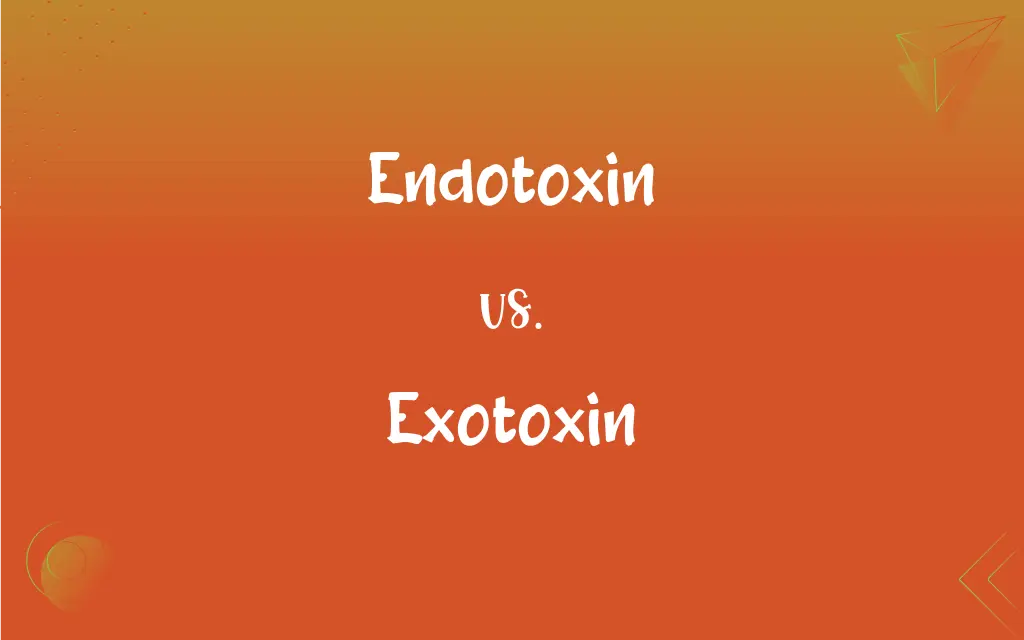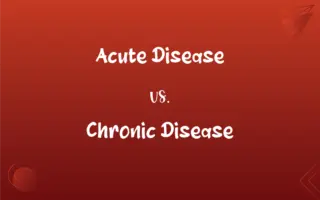Endotoxin vs. Exotoxin: What's the Difference?
Edited by Janet White || By Harlon Moss || Updated on October 29, 2023
Endotoxin is a lipopolysaccharide in bacterial cell walls, causing fever and inflammation; exotoxin is a secreted protein from bacteria, causing specific disease symptoms.

Key Differences
Endotoxin and exotoxin originate from bacteria. Endotoxin is a component of the outer membrane of Gram-negative bacteria. On the other hand, exotoxin is a protein toxin actively secreted by both Gram-positive and Gram-negative bacteria.
Endotoxin triggers a strong immune response, causing symptoms like fever and inflammation. In contrast, exotoxin targets specific cells, leading to symptoms specific to the toxin's activity, which can range from diarrhea to paralysis.
Both endotoxin and exotoxin can cause harm, but their mechanisms differ. Endotoxins work by stimulating immune responses, potentially leading to septic shock. Exotoxins function by directly attacking host cells, often damaging or destroying them.
Endotoxins are heat-stable and are not easily destroyed by boiling, whereas exotoxins are usually heat-labile and can be inactivated by boiling.
While endotoxins are an intrinsic part of the bacterial cell wall and released only upon cell death, exotoxins are produced and actively secreted by living bacterial cells.
ADVERTISEMENT
Comparison Chart
Origin
Gram-negative bacteria
Both Gram-positive and Gram-negative
Nature
Lipopolysaccharide
Protein
Release Mechanism
Released upon bacterial cell death
Actively secreted by living bacterial cells
Heat Stability
Heat stable
Usually heat-labile
Effect on Host
Fever, inflammation
Specific disease symptoms
ADVERTISEMENT
Endotoxin and Exotoxin Definitions
Endotoxin
Endotoxin's effects are more generalized than those of exotoxins.
Endotoxin exposure can lead to a variety of symptoms due to its systemic effects on the body.
Exotoxin
Exotoxins target specific cells or tissues in the host, leading to distinct disease symptoms.
The diphtheria exotoxin specifically targets throat tissues, causing inflammation and pseudomembrane formation.
Endotoxin
Endotoxins are released when Gram-negative bacteria die and their cell walls disintegrate.
The lysis of bacterial cells can lead to an increased concentration of endotoxin.
Exotoxin
Exotoxin is a potent protein toxin secreted by bacteria to harm host cells.
Botulinum toxin, an exotoxin, causes the disease botulism.
Endotoxin
Endotoxins are heat-stable and cannot be easily neutralized by boiling.
Boiling may not be effective in removing endotoxin from contaminated solutions.
Exotoxin
Exotoxins are produced by both Gram-positive and Gram-negative bacteria.
The exotoxin from Staphylococcus aureus causes food poisoning symptoms.
Endotoxin
Endotoxin is a lipopolysaccharide component of the outer membrane of Gram-negative bacteria.
Infections with Gram-negative bacteria can lead to the release of endotoxin, inducing strong immune responses.
Exotoxin
Exotoxins are usually heat-labile, meaning they can be inactivated by heating.
Boiling food can help inactivate any exotoxins present, reducing the risk of food poisoning.
Endotoxin
Endotoxins induce a broad range of immune responses, including fever and inflammation.
The presence of endotoxin in the bloodstream can result in septic shock.
Exotoxin
Exotoxins often have enzymatic activities that help them interfere with host cell functions.
The exotoxin from Vibrio cholerae alters the host cell's ion transport, leading to diarrhea.
Endotoxin
A toxin produced by certain bacteria and released upon destruction of the bacterial cell.
Exotoxin
A poisonous substance secreted by a microorganism and released into the medium in which it grows.
Endotoxin
Any toxin secreted by a microorganism and released into the surrounding environment only when it dies.
Exotoxin
Any toxin secreted by a microorganism into the surrounding environment.
Endotoxin
A toxin that is confined inside the microorganisms and is released only when the microorganisms are broken down or die
Exotoxin
A toxin that is secreted by microorganisms into the surrounding medium
FAQs
Where is exotoxin found?
Exotoxin is a protein secreted by both Gram-positive and Gram-negative bacteria.
What diseases are caused by exotoxins?
Diseases like diphtheria, tetanus, and botulism are caused by exotoxins.
Can exotoxin be destroyed by boiling?
Usually, exotoxins are heat-labile and can be inactivated by boiling.
Are exotoxins always harmful?
Most exotoxins have harmful effects, but some have been used therapeutically, like Botox.
How can we protect ourselves from endotoxins?
Preventing Gram-negative bacterial infections and ensuring clean environments can help.
Do endotoxins have a specific target in the body?
Endotoxins generally have broad effects, unlike exotoxins, which often target specific cells or tissues.
How does endotoxin affect the body?
Endotoxin triggers immune responses, causing fever and inflammation.
Is endotoxin heat-stable?
Yes, endotoxins are usually heat-stable.
What is endotoxin?
Endotoxin is a lipopolysaccharide component of Gram-negative bacterial cell walls.
Can exotoxins cause paralysis?
Yes, certain exotoxins, like botulinum toxin, can cause paralysis.
Are endotoxins proteins?
No, endotoxins are lipopolysaccharides.
Can endotoxin cause septic shock?
Yes, high levels of endotoxin can lead to septic shock.
Can endotoxins be neutralized?
Some treatments can neutralize the effects of endotoxins, but they are not easily destroyed.
Can exotoxins be used in bioterrorism?
Some exotoxins have the potential to be used as bioterror agents due to their potency.
Is endotoxin found in all bacteria?
No, endotoxin is specific to Gram-negative bacteria.
Which is more harmful, endotoxin or exotoxin?
Both can be harmful, but exotoxins often have more specific and potent effects.
Is there a test for exotoxin presence?
Yes, there are various tests to detect specific exotoxins in medical settings.
Do antibiotics always neutralize exotoxins?
Antibiotics kill bacteria but don't always neutralize pre-existing exotoxins.
How are endotoxins released?
Endotoxins are released upon the death of Gram-negative bacteria.
Are all exotoxins the same?
No, different bacteria produce different exotoxins with varying effects.
About Author
Written by
Harlon MossHarlon is a seasoned quality moderator and accomplished content writer for Difference Wiki. An alumnus of the prestigious University of California, he earned his degree in Computer Science. Leveraging his academic background, Harlon brings a meticulous and informed perspective to his work, ensuring content accuracy and excellence.
Edited by
Janet WhiteJanet White has been an esteemed writer and blogger for Difference Wiki. Holding a Master's degree in Science and Medical Journalism from the prestigious Boston University, she has consistently demonstrated her expertise and passion for her field. When she's not immersed in her work, Janet relishes her time exercising, delving into a good book, and cherishing moments with friends and family.































































